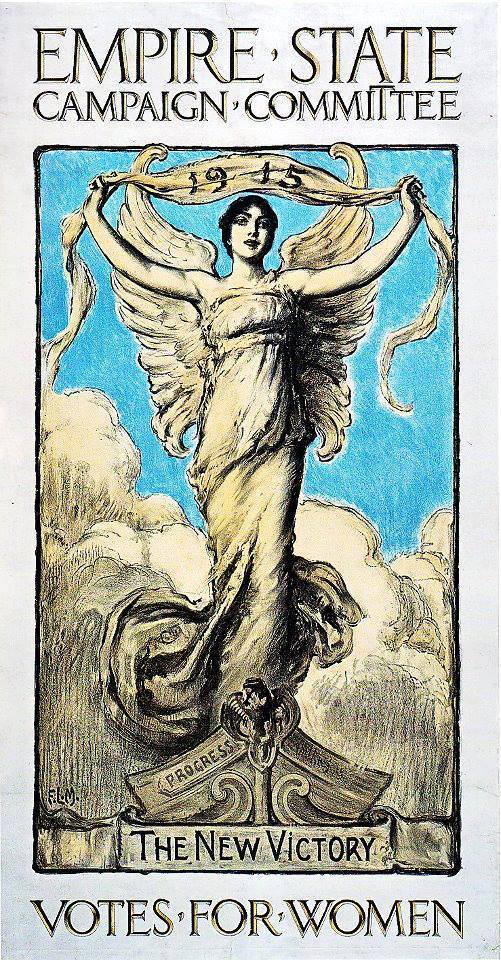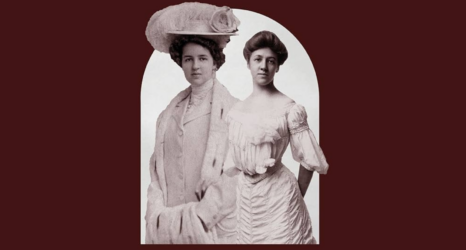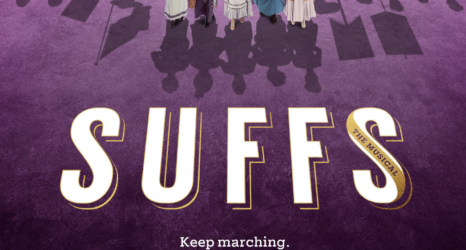
Today in Feminist History is our daily recap of the major milestones and minor advancements that shaped women’s history in the U.S.—from suffrage to Shirley Chisholm and beyond. These posts were written by, and are presented in homage to, our late staff historian and archivist, David Dismore.
May 22, 1915: The major differences in philosophies and tactics used by suffrage groups were openly illustrated today through a number of public comments.

Though all suffragists have the same goal of “Votes for Women,” some give priority to winning suffrage on a State-by-State basis, using conventional methods, while others focus on passage of the Susan B. Anthony Amendment, and take a more militant, though non-violent, approach.
The Empire State Campaign Committee is currently working hard to pass a suffrage referendum in New York State in November, and is quite concerned that the actions of the Congressional Union for Woman Suffrage might offend some in the all-male electorate who will be voting on the measure. Carrie Chapman Catt is head of the Committee, and recently sent a letter to Alice Paul, head of the Congressional Union, asking her not to organize in New York State until after the election.
Alice Paul told Catt that though the C.U. has a headquarters in New York City, it is just a central location to direct work nationwide. While the Congressional Union plans to organize in every State, they will wait until after the election to do so in those which have referenda on the ballot, in order not to interfere with those efforts. But individual Congressional Union members will still continue to work in every State, including New York.
Paul stated today that since the C.U.’s priority is a Constitutional amendment, this will require visiting every member of Congress, including those in the four States (New York, New Jersey, Pennsylvania and Massachusetts) which will vote on woman suffrage this Fall. In some cases, this will require visiting the member’s home office.
Copies of Catt’s letter to Alice Paul, which is reported to be quite polite, were recently sent around the country to other suffragists, and accompanied by a note signed by the National American Woman Suffrage Association that more accurately reflects the growing rift:
“War has been declared upon the National by a new militant organization which enjoys autocratic leadership and a philosophic irresponsibility to the suffrage movement in the various States.”
Katharine Dexter McCormick, N.A.W.S.A. Vice President, was even more outspoken today:
“There has been entire harmony between the National Association and the workers in the State, but we have all had to suffer from the amazing selfishness of a small group which is determined to figure in the day’s news no matter who pays the bills.
“We have been flooded with telegrams from suffragists throughout the country deploring the effect of the Congressional Union’s attack upon the President in two campaign States—last week in Pennsylvania and this week in New York. The only thing to do is to bend every effort to convince the public—and especially the men—that, as Mrs. Catt has said, ninety-nine and nine tenths percent of the suffragists have no sympathy with such undignified and preposterous methods. It is the work of a small band which enjoy autocratic leadership and a fine contempt for the slow, solid methods which American women have preferred and still prefer.”
The Congressional Union for Woman Suffrage was formed in April, 1913, by Alice Paul and Lucy Burns. Paul had been head of N.A.W.S.A.’s Congressional Committee, and organized its hugely successful pageant in Washington, D.C., the month before. But philosophical incompatibilities soon required Paul to separate from N.A.W.S.A., and use her new and independent group to take a more militant approach.
N.A.W.S.A. has been concentrating on State referenda, along with some polite lobbying of members of Congress for a watered-down suffrage amendment. The Shafroth-Palmer Amendment, which they endorsed last year, directly enfranchises no one, and would only require States to hold a referendum on woman suffrage if 8 percent of the registered—male—voters sign a petition. The C.U. insists on nothing less than the Anthony Amendment, which would immediately enfranchise women on the same basis as men nationwide.
The Congressional Union has begun attacking the party in power, which has the ability to pass the Anthony Amendment, but has not done so. It was these attacks on Democrats in last year’s midterm elections, and repeated attempts to pressure President Wilson to support nationwide woman suffrage that have upset N.A.W.S.A. and the Empire State Campaign Committee.
Though it obviously does not help matters to have group rivalries and animosity between major figures in the struggle for suffrage, the current situation does show that a lot of people still have a strong commitment to winning “Votes for Women,” even if they strenuously differ on how it should be accomplished. In fact, in the long run, it seems quite likely that a combination of strategies may be the best, with some politicians and voters responding to N.A.W.S.A.’s gentle lobbying and traditional methods, and others being swayed by the Congressional Union’s aggressive lobbying and unconventional methods of capturing the attention of press and public.





